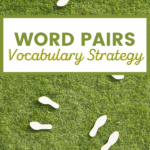If you ever need a no-prep, effective, high-level thinking activity for vocabulary, this is the one.
In the Word Pairs vocabulary strategy, students evaluate the connections between pairs of words.
They determine if the words are the same, opposite, go together, or are unrelated.
Let’s look at how it works in a classroom.
? How Does the Word Pairs Strategy Work Exactly?
To use this strategy, the teacher selects words students will analyze.
Give them the words and have them analyze the relationship between the words, keeping in mind that there might be more than one.
The relationship choices are: the same, opposite, go together, and no relation.
This strategy, found in Steven Stahl’s book Word Power: What Every Educator Needs to Know about Teaching Vocabulary, is a low-prep, powerful tool for analyzing words.
You can have them do this by themselves, in pairs, or in small groups.
In the book, Stahl says that students should fill in a chart like the one here:
| Same | Opposite | Go Together | No Relation | |
|---|---|---|---|---|
| lemon – apple | X | |||
| peninsula – lake | X | |||
| country – nation | X | |||
| acid – base | X |
The problem for me is that my students can often argue multiple points, so I like an additional column that says reasoning or notes. I also allow students to identify more than one relationship.
For example, in the table above, I listed acid-base as opposites, but they are both on the pH scale, so you could definitely argue they go together in that way.
If students want to put a word pair in more than one category, I have them chose a capital X for the category they think is the strongest relationship and a lower case x for the category think is secondary.
In the book, Stahl describes using this strategy with words they’ve been studying, and I think that’s great. However, you don’t need to try pick words because they don’t need to have an obvious connection.
Both finding and forcing relationships have power, so don’t get hung up on making sure that there’s a connection to be found. Your students will surprise you with the connections they find!
? Variations on the Word Pairs Strategy
The strategy Stahl describes is terrific.
I have created a number of variations of it that you can use, too.
- Have the entire class work on the same set of words or have them all work with different groups of words.
- Give them the words in pairs or let them select pairs of words from the set of words you’ve chosen.
- Create different categories for the sort, such as friends, neighbors, enemies, or unknown. The sky’s the limit with this one.
- Write words on popsicle sticks (either real or use some digital selection tool) and have a student draw two sticks and make the comparison. You can do this in teams, if you wish. This is really fun!
- Award certain pairs that are analyzed with particular perception, such as least likely connection, best analysis, most creative use of a word, etc.
- Let students take a group of pairs of words and create four categories to sort them into. (If you like this idea, be sure to check out the Harry Potter Sorting Hat Strategy.)
- Show word pairs on a screen instead of giving them a chart with the words already on it. That way, you can reuse a generic chart, either virtually or on paper.
? What are the Benefits of the Word Pairs Strategy?
The Word Pairs strategy is one of the strategies that supports what research tells us about multiple exposures to vocabulary words. We have to do these multiple exposures in many ways, so this is a great activity to have at the ready.
Stahl says the best part of the activity is the discussion with the entire class, and I’m not sure I agree with him on that. I may be the most interesting and rewarding, but the core power of the activity mentally is that connection the student made.
If you use the Depth and Complexity framework, this is a great activity because it’s not only Language of the Discipline, but also Across Disciplines.
To use it as an Across Disciplines activity, have students analyze the words in one of two ways:
- Compare two words from different fields (compare a triangle to the Allied Powers in WWII), or
- Compare two words from across the same discipline (compare triangle to dodecahedron).
Because it can be done independently, in pairs or in small groups, it’s a nice, flexible activity, as well.
? Wrapping Up:
The Word Pairs strategy is one of my favorites because it’s so flexible.
You can make it a very quick little practice exercise, or you can spend an entire class segment or period on it.
I hope you’ll try it because I think both you and your students will enjoy it and get a lot of benefit out of it. ?
? You May Also Like:
- How to Teach Vocabulary with Depth & Complexity Frames
- How to Use a Linear Array to Teach Vocabulary
- Teaching Using the I Spy Activity
Want to be a Vocabulary Luau insider? Sign up here & grab your free two-page list of vocabulary question stems. I’d love to have you join the party!????


